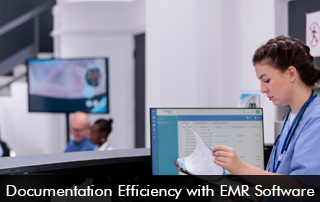Clinical documentation can be tedious for healthcare providers. Clinicians are already in a stressful profession and note-taking and charting add to the stress leading to burnout. Fortunately, speech-to-text integration in Electronic Medical Records (EMR) Software can alleviate physician workload by streamlining the documentation process during patient encounters. EHR Software technology and healthcare services are one of the fastest-growing sectors. Robust tools in EMR systems can help optimize processes to boost practice efficiency like never before.
Clinical Documentation Difficulties
Manual data entry is time-consuming and inefficient. For providers that don’t use EMR Software technology and functionalities that simplify the charting process then the following challenges arise:
- There is always a possibility of errors due to manual data entry. Written notes can also be difficult to read in some cases.
- Incomplete documentation can have serious repercussions on patient care.
- With manual documentation, healthcare providers can provide care to fewer patients. This will ultimately affect the revenue stream.
- The lack of standardization with hand-written documentation can confuse medical billers and coders.
Documentation Efficiency with Voice Recognition Tools in EHR Software System
Voice recognition features in electronic medical records software can drastically improve clinical documentation. This gives more time for providers to focus on what they are passionate about – Offering high-quality care to their patients.
Here’s how the charting process can be streamlined when Electronic Medical Records Software technology is utilized:
Real-Time Documentation
Healthcare providers can instantly record patient encounters using voice recognition technology in EHR Software. Doctors can talk directly into the system, assuring accuracy and saving time, rather than transcribing notes by hand or utilizing templates.
Efficient and Faster Data Entry
Voice recognition features make it possible for healthcare professionals to enter patient data considerably more quickly than they could by typing. Increased patient throughput and reduced wait times for patients are favorable outcomes of efficient clinical documentation.
Improved Accessibility
Electronic Health Records (EHR) Software systems are more accessible to clinicians with disabilities or non-proficient typists due to voice recognition features. All healthcare professionals will be able to utilize the program to efficiently record patient contacts with its inclusivity.
Mobile Access
Most of the voice recognition tools in the EMR Software are accessible via smartphones. This means that physicians can easily document on the go using their phones. Now they don’t have to be tied to the office desk to complete charting tasks.
Top 5 EHR Software Vendors that Offer the Best Charting Tools
Our EHR software experts have shortlisted the top 5 vendors that offer grade-A charting tools. These solutions can fit user needs and can automate and streamline clinical documentation to enhance efficiency levels and boost health outcomes:








